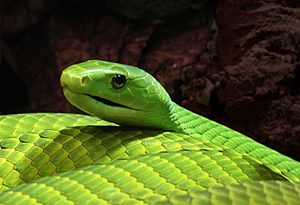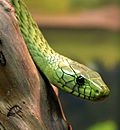Mamba facts for kids
Quick facts for kids Dendroaspis |
|
|---|---|
 |
|
| Black mamba | |
| Scientific classification | |
| Kingdom: | |
| Subphylum: | |
| Class: | |
| Order: | |
| Suborder: | |
| Family: | |
| Genus: |
Dendroaspis
|
Mambas are quick and dangerous venomous snakes found in Africa. They belong to a group of snakes called Dendroaspis, which means "tree asp."
The black mamba is one of the most famous and feared types of mamba. Most mambas live in trees and are active during the day. They usually try to stay away from people.
Contents
Mamba Behavior and Habitat
There are three types of green mambas, and they all live in trees. The black mamba, however, mostly lives on the ground. All four types of mambas hunt during the day. They eat birds, lizards, and small mammals.
When night comes, some mambas, especially the black mamba, find a safe place to rest. A mamba might even use the same resting spot for many years!
How Mambas Defend Themselves
Mambas are related to cobras. Both are part of the Elapidae snake family. Like cobras, a mamba can raise its head and flatten its neck to form a "hood" when it feels threatened. A mamba's hood is narrower and longer than a cobra's.
When a mamba feels scared, it often opens its mouth wide. The inside of a black mamba's mouth is very dark, which makes its warning look even scarier. Unlike cobras, which stand very straight, a mamba usually leans forward when it raises its head to threaten.
Even though there are many stories about black mambas chasing people, these snakes usually try to avoid humans. Most times, if a mamba seems to be chasing someone, it's actually just trying to escape to its hiding place, and a person happens to be in the way. Black mambas use their speed to get away from danger. Humans are actually more of a threat to them than the other way around.
Mamba Venom
All mambas have very strong venom. Their venom mainly contains special poisons called neurotoxins, also known as dendrotoxins. These poisons attack the nervous system. Mamba venom also has other harmful substances that can affect the heart and muscles.
The strength of a mamba's venom can change based on things like where the snake lives, the weather, and how high up it is. If a person is bitten by a mamba and doesn't get help quickly, the venom can stop their lungs and heart from working. This can be deadly.
The venom of the western green mamba, eastern green mamba, and Jameson's mamba is similar to the black mamba's venom. However, their venom is not as strong, and these snakes are usually less aggressive. They also inject less venom when they bite. Because of this, their bites are not as dangerous as a black mamba's bite.
Before doctors had antivenom, almost everyone who was bitten by a black mamba died. But now, with antivenom widely available, deaths from mamba bites are much rarer. Antivenom is a medicine that helps stop the venom from harming the body.
Mamba Types and Names
The name Dendroaspis comes from ancient Greek words. "Dendro" means "tree," and "aspis" means "shield," but it was also used to mean "cobra" or "snake," especially a snake with a hood. So, "Dendroaspis" literally means "tree asp," which makes sense because most mambas live in trees.
There are four types of mambas that we know of today. Three of them are green, and one is called the "black mamba," even though its body is usually brown or gray.
Images for kids
See also
 In Spanish: Mambas para niños
In Spanish: Mambas para niños







